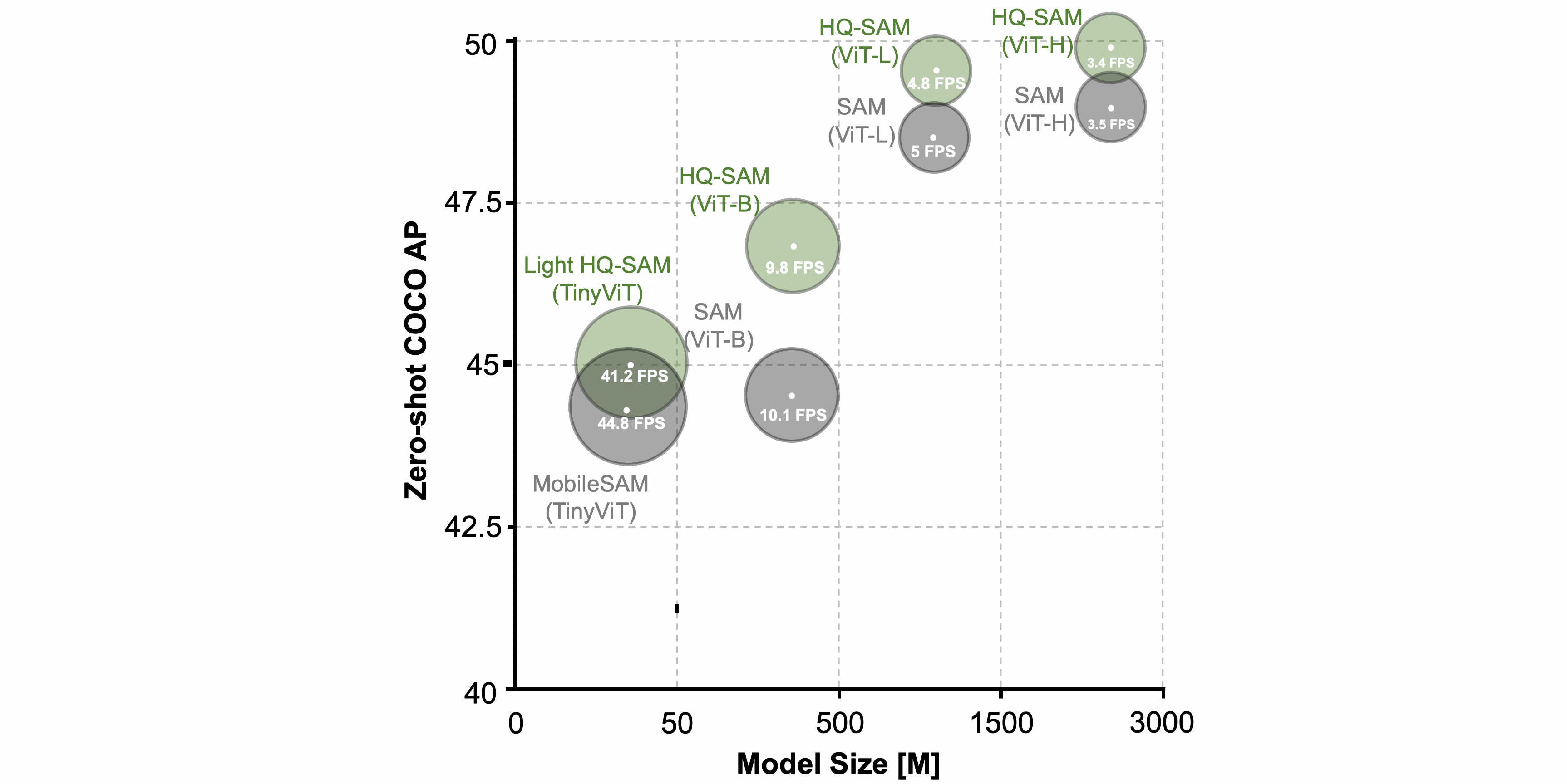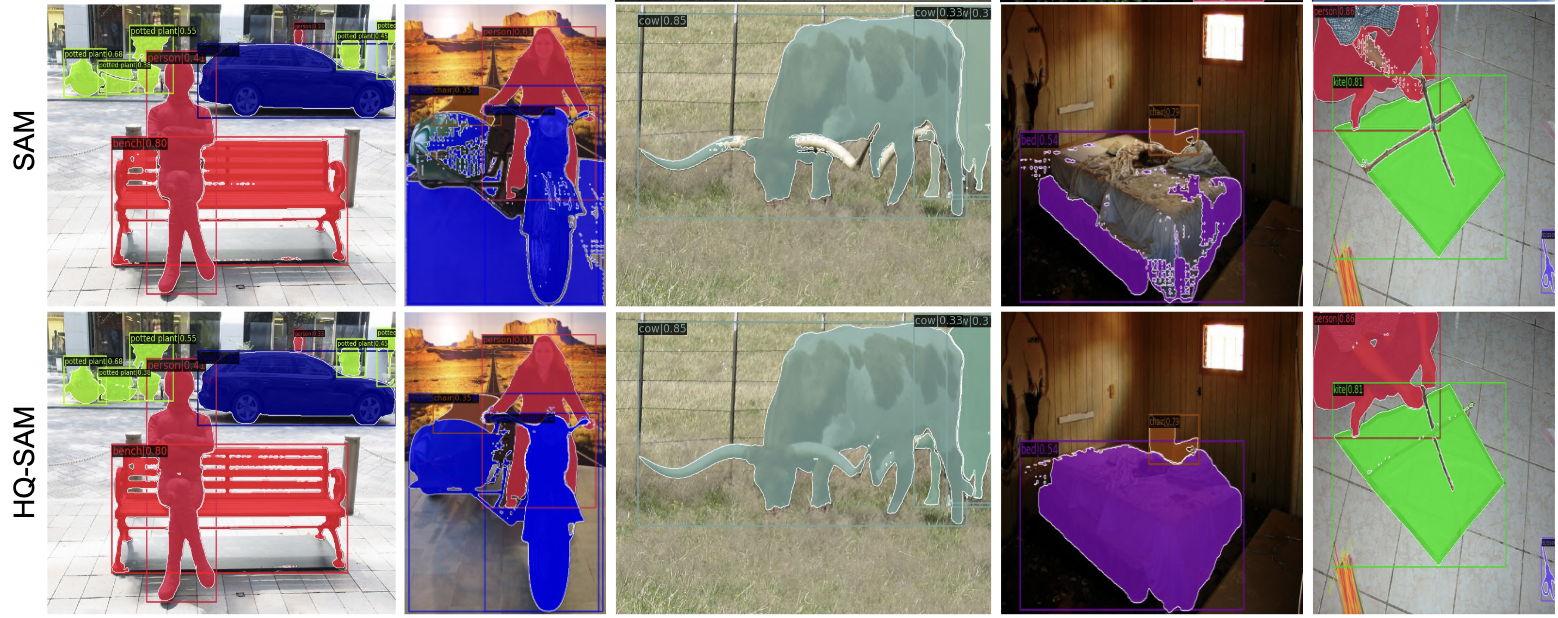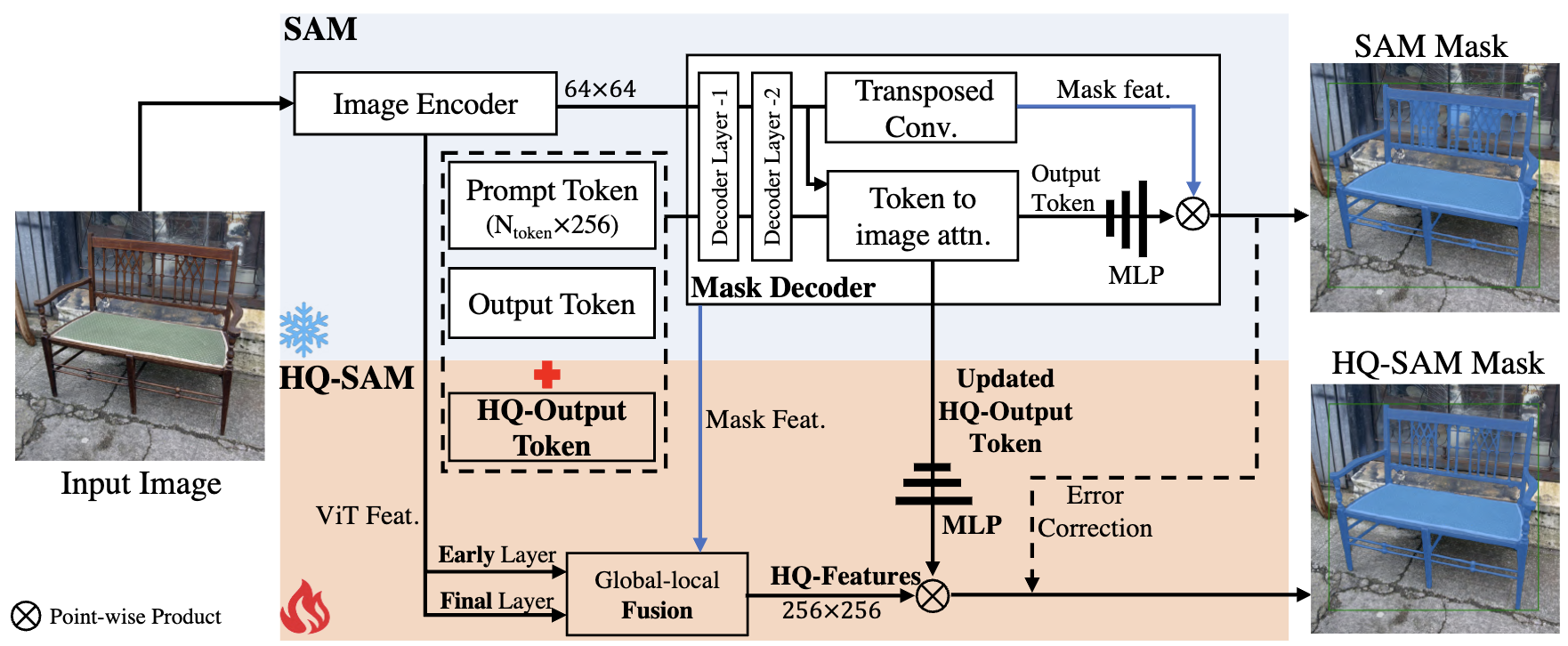Segment Anything in High Quality
Lei Ke, Mingqiao Ye, Martin Danelljan, Yifan Liu, Yu-Wing Tai, Chi-Keung Tang, Fisher Yu
ETH Zurich & HKUST
We propose HQ-SAM to upgrade SAM for high-quality zero-shot segmentation. Refer to our paper for more details.
2023/07/21: HQ-SAM is also in OpenXLab apps, thanks their support!
🚀🚀 2023/07/17: We released Light HQ-SAM using TinyViT as backbone, for both fast and high-quality zero-shot segmentation, which reaches 41.2 FPS. Refer to Light HQ-SAM vs. MobileSAM for more details.
🏆🥇 2023/07/14: Grounded HQ-SAM obtains the first place🥇 in the Segmentation in the Wild competition on zero-shot track (hosted in CVPR 2023 workshop), outperforming Grounded SAM. Refer to our SegInW evaluation for more details.
🔥🔥 2023/07/05: We released SAM tuning instuctions and HQSeg-44K data.
2023/07/04: HQ-SAM is adopted in SAM-PT to improve the SAM-based zero-shot video segmentation performance. Also, HQ-SAM is used in Grounded-SAM and Inpaint Anything.
2023/06/28: We released the ONNX export script and colab notebook for exporting and using ONNX model.
2023/06/23: Play with HQ-SAM demo at 
2023/06/14: We released the colab demo and automatic mask generator notebook.
2023/06/13: We released the model checkpoints and demo visualization codes.
SAM vs. HQ-SAM
 |
 |
 |
 |
 |
 |
The recent Segment Anything Model (SAM) represents a big leap in scaling up segmentation models, allowing for powerful zero-shot capabilities and flexible prompting. Despite being trained with 1.1 billion masks, SAM's mask prediction quality falls short in many cases, particularly when dealing with objects that have intricate structures. We propose HQ-SAM, equipping SAM with the ability to accurately segment any object, while maintaining SAM's original promptable design, efficiency, and zero-shot generalizability. Our careful design reuses and preserves the pre-trained model weights of SAM, while only introducing minimal additional parameters and computation. We design a learnable High-Quality Output Token, which is injected into SAM's mask decoder and is responsible for predicting the high-quality mask. Instead of only applying it on mask-decoder features, we first fuse them with early and final ViT features for improved mask details. To train our introduced learnable parameters, we compose a dataset of 44K fine-grained masks from several sources. HQ-SAM is only trained on the introduced detaset of 44k masks, which takes only 4 hours on 8 GPUs. We show the efficacy of HQ-SAM in a suite of 9 diverse segmentation datasets across different downstream tasks, where 7 out of them are evaluated in a zero-shot transfer protocol.
Note: For box-prompting-based evaluation, we feed SAM, MobileSAM and our HQ-SAM with the same image/video bounding boxes and adopt the single mask output mode of SAM.
We provide comprehensive performance, model size and speed comparison on SAM variants:

 Note: For the COCO dataset, we use a SOTA detector FocalNet-DINO trained on the COCO dataset as our box prompt generator.
Note: For the COCO dataset, we use a SOTA detector FocalNet-DINO trained on the COCO dataset as our box prompt generator.
Note:Using ViT-L backbone. We adopt the SOTA detector Mask2Former trained on the YouTubeVIS 2019 dataset as our video boxes prompt generator while reusing its object association prediction.

Note: Using ViT-L backbone. We adopt the SOTA model XMem as our video boxes prompt generator while reusing its object association prediction.

Note:Using ViT-L backbone. On the high-quality COIFT (zero-shot) and DIS val set.

The code requires python>=3.8, as well as pytorch>=1.7 and torchvision>=0.8. Please follow the instructions here to install both PyTorch and TorchVision dependencies. Installing both PyTorch and TorchVision with CUDA support is strongly recommended.
Clone the repository locally and install with
git clone https://github.com/SysCV/sam-hq.git
cd sam-hq; pip install -e .
The following optional dependencies are necessary for mask post-processing, saving masks in COCO format, the example notebooks, and exporting the model in ONNX format. jupyter is also required to run the example notebooks.
pip install opencv-python pycocotools matplotlib onnxruntime onnx timm
conda create --name sam_hq python=3.8 -y
conda activate sam_hq
conda install pytorch==1.10.0 torchvision==0.11.0 cudatoolkit=11.1 -c pytorch -c nvidia
pip install opencv-python pycocotools matplotlib onnxruntime onnx timm
# under your working directory
git clone https://github.com/SysCV/sam-hq.git
cd sam-hq
pip install -e .
export PYTHONPATH=$(pwd)Three HQ-SAM model versions of the model are available with different backbone sizes. These models can be instantiated by running
from segment_anything import sam_model_registry
sam = sam_model_registry["<model_type>"](checkpoint="<path/to/checkpoint>")
Download the provided trained model below and put them into the pretrained_checkpoint folder:
mkdir pretrained_checkpoint
Click the links below to download the checkpoint for the corresponding model type. We also provide alternative model downloading links here or at hugging face.
vit_b: ViT-B HQ-SAM model.vit_l: ViT-L HQ-SAM model.vit_h: ViT-H HQ-SAM model.vit_tiny(Light HQ-SAM for real-time need): ViT-Tiny HQ-SAM model.
First download a model checkpoint. Then the model can be used in just a few lines to get masks from a given prompt:
from segment_anything import SamPredictor, sam_model_registry
sam = sam_model_registry["<model_type>"](checkpoint="<path/to/checkpoint>")
predictor = SamPredictor(sam)
predictor.set_image(<your_image>)
masks, _, _ = predictor.predict(<input_prompts>)
Additionally, see the usage examples in our demo , colab notebook and automatic mask generator notebook.
To obtain HQ-SAM's visual result:
python demo/demo_hqsam.py
To obtain baseline SAM's visual result. Note that you need to download original SAM checkpoint from baseline-SAM-L model and put it into the pretrained_checkpoint folder.
python demo/demo_sam.py
To obtain Light HQ-SAM's visual result:
python demo/demo_hqsam_light.py
We provide detailed training, evaluation, visualization and data downloading instructions in HQ-SAM training.
Please change the current folder path to:
cd train
and then refer to detailed readme instruction.
Grounded HQ-SAM vs Grounded SAM on SegInW
Grounded HQ-SAM wins the first place🥇 on SegInW benchmark (consist of 25 public zero-shot in the wild segmentation datasets), and outpuerforming Grounded SAM using the same grounding-dino detector.
| Model Name | Encoder | GroundingDINO | Mean AP | Evaluation Script | Log | Output Json |
|---|---|---|---|---|---|---|
| Grounded SAM | vit-h | swin-b | 48.7 | script | log | result |
| Grounded HQ-SAM | vit-h | swin-b | 49.6 | script | log | result |
Please change the current folder path to:
cd seginw
We provide detailed evaluation instructions and metrics on SegInW in Grounded-HQ-SAM evaluation.
We propose Light HQ-SAM based on the tiny vit image encoder provided by MobileSAM. We provide quantitative comparison on zero-shot COCO performance, speed and memory below. Try Light HQ-SAM at here.
| Model | Encoder | AP | AP@L | AP@M | AP@S | Model Params (MB) | FPS | Memory (GB) |
|---|---|---|---|---|---|---|---|---|
| MobileSAM | TinyViT | 44.3 | 61.8 | 48.1 | 28.8 | 38.6 | 44.8 | 3.7 |
| Light HQ-SAM | TinyViT | 45.0 | 62.8 | 48.8 | 29.2 | 40.3 | 41.2 | 3.7 |
Note: For the COCO dataset, we use the same SOTA detector FocalNet-DINO trained on the COCO dataset as our and Mobile sam's box prompt generator.
HQ-SAM's lightweight mask decoder can be exported to ONNX format so that it can be run in any environment that supports ONNX runtime. Export the model with
python scripts/export_onnx_model.py --checkpoint <path/to/checkpoint> --model-type <model_type> --output <path/to/output>
See the example notebook for details on how to combine image preprocessing via HQ-SAM's backbone with mask prediction using the ONNX model. It is recommended to use the latest stable version of PyTorch for ONNX export.
If you find HQ-SAM useful in your research or refer to the provided baseline results, please star ⭐ this repository and consider citing 📝:
@article{sam_hq,
title={Segment Anything in High Quality},
author={Ke, Lei and Ye, Mingqiao and Danelljan, Martin and Liu, Yifan and Tai, Yu-Wing and Tang, Chi-Keung and Yu, Fisher},
journal = {arXiv:2306.01567},
year = {2023}
}
- Thanks SAM, Grounded SAM and MobileSAM for their public code and released models.



